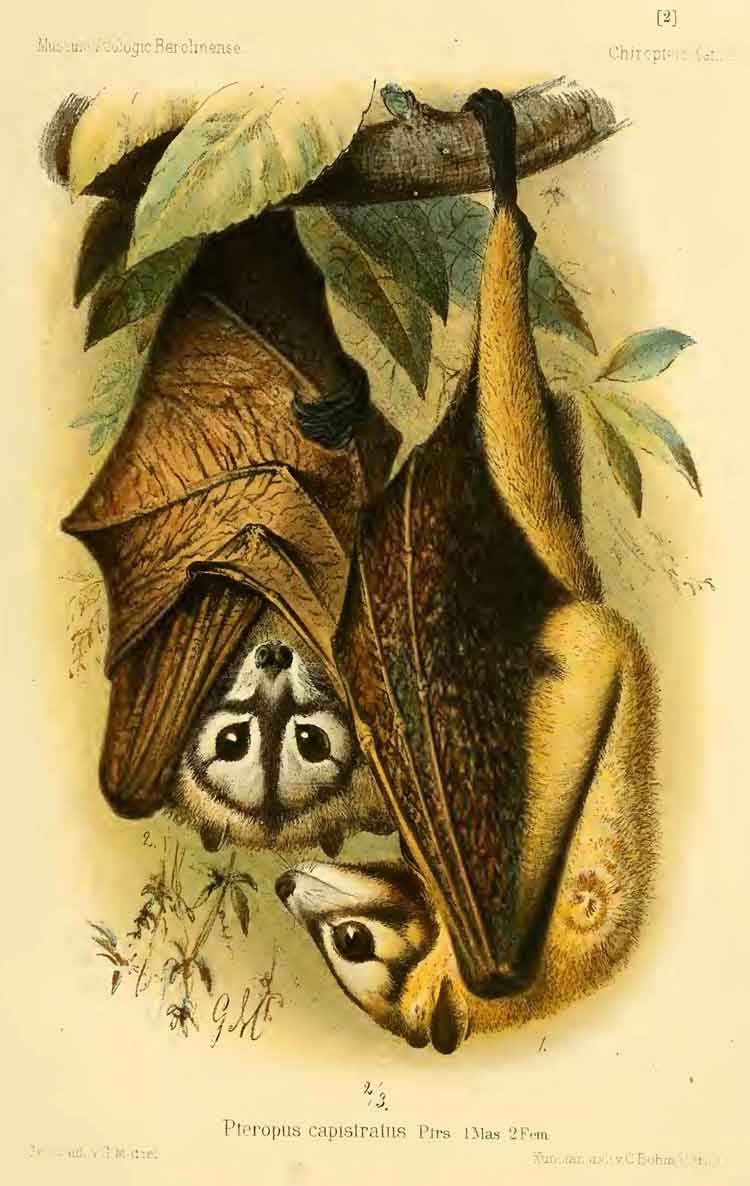
Superregnum: Eukaryota
Cladus: Unikonta
Cladus: Opisthokonta
Cladus: Holozoa
Regnum: Animalia
Subregnum: Eumetazoa
Cladus: Bilateria
Cladus: Nephrozoa
Superphylum: Deuterostomia
Phylum: Chordata
Subphylum: Vertebrata
Infraphylum: Gnathostomata
Megaclassis: Osteichthyes
Cladus: Sarcopterygii
Cladus: Rhipidistia
Cladus: Tetrapodomorpha
Cladus: Eotetrapodiformes
Cladus: Elpistostegalia
Superclassis: Tetrapoda
Cladus: Reptiliomorpha
Cladus: Amniota
Cladus: Synapsida
Cladus: Eupelycosauria
Cladus: Sphenacodontia
Cladus: Sphenacodontoidea
Cladus: Therapsida
Cladus: Theriodontia
Cladus: Cynodontia
Cladus: Eucynodontia
Cladus: Probainognathia
Cladus: Prozostrodontia
Cladus: Mammaliaformes
Classis: Mammalia
Subclassis: Trechnotheria
Infraclassis: Zatheria
Supercohors: Theria
Cohors: Eutheria
Infraclassis: Placentalia
Cladus: Boreoeutheria
Superordo: Laurasiatheria
Cladus: Scrotifera
Ordo: Chiroptera
Subordo: Yinpterochiroptera
Familia: Pteropodidae
Subfamilia: Pteropodinae
Tribus: Pteropodini
Genus: Pteropus
Species: Pteropus capistratus
Subspecies: P. c. capistratus – P. c. ennisae
Name
Pteropus capistratus Peters, 1876
Type locality: Papua New Guinea.
References
Peters. 1876. Monatsberichte der Koniglich Preussischen Akademie der Wissenschaften zu Berlin, 1876: 316.
Distribution
Bismarck Arch. (Papua New Guinea)
Vernacular names
English: Bismark Masked Flying Fox.
The Bismarck masked flying fox (Pteropus capistratus) is a species of flying fox in the family Pteropodidae found in Papua New Guinea and named after the Bismarck Archipelago. It was once considered a subspecies of Pteropus temminckii before being reassessed in 2001. This species has two subspecies, P. c. capistratus and P. c. ennisae.[2] The IUCN classified it as Near Threatened in 2009, noting that the rate of decline is almost high enough to reclassify the species as Vulnerable.[1]
Taxonomy
The Bismarck masked flying fox was described as a new species in 1867 by German naturalist Wilhelm Peters.[3] Prior to 1995, the Bismarck masked flying fox was largely considered a subspecies of the Temminck's flying fox (Pteropus temminckii).[4]
Description
Its forearm length is 109–118 mm (4.3–4.6 in).[5]
Biology and ecology
It is one of the rare species of mammals in which the males can lactate.[6] It is generally solitary, though males and females may roost together in pairs.[7]: 6
Range and habitat
The Bismarck masked flying fox is endemic to Papua New Guinea where it has been documented at a range of elevations from 0–1,200 m (0–3,937 ft) above sea level.[1]
Conservation
As of 2021, it is evaluated as a vulnerable species by the IUCN. It meets the criteria for this designation because it has a small population size, likely numbering fewer than 10,000 mature individuals. It is experiencing significant habitat loss and population decline.[1]
References
Pennay, M.; Lavery, T.H.; Roberts, B. (2021). "Pteropus capistratus". IUCN Red List of Threatened Species. 2021: e.T84891540A22012219. doi:10.2305/IUCN.UK.2021-3.RLTS.T84891540A22012219.en. Retrieved 16 December 2023.
D.E. Wilson & D.M. Reeder, 2005: Mammal Species of the World: A Taxonomic and Geographic Reference. Third Edition. The Johns Hopkins University Press, Baltimore
Peters, W. (1867). "Mittheilung über die Pelzrobbe von den Inseln St. Paul und Amsterdam und über die von S.M.S. Gazelle mitgebrachten Flederthiere" [Communication about the fur seals from the islands of St. Paul and Amsterdam and those of S.M.S. Gazelle brought along bats]. Monatsberichte der Königlichen Preussische Akademie des Wissenschaften zu Berlin (in German): 316–317.
"Pteropus capistratus". ITIS. Retrieved 17 August 2019.
Flannery, T. F. (1995). Mammals of the south-west Pacific & Moluccan Islands. Cornell University Press. p. 184. ISBN 978-0801431500.
Bats: A World of Science and Mystery (Hardcover) by M. Brock Fenton, Nancy B. Simmons, p. 168.
Pierson, E. D.; Rainey, W. E. (1992). "The biology of flying foxes of the genus Pteropus: a review". Biological Report. 90 (23).
Retrieved from "http://en.wikipedia.org/"
All text is available under the terms of the GNU Free Documentation License

